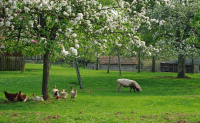 NOTICIAS
NOTICIAS
Researchers to map poultry and swine microbiomes to improve animal production
Image from Fablegros via Pixabay
A new European research project, 3D’omics, aims to address major challenges in animal production by creating and optimising a technology to analyse animal-microbiota interactions at the microscale. The technology will mainly be used for poultry and swine. The project consortium, led by the University of Copenhagen, includes scientists from eight European universities and research institutions, as well as five different companies from the private sector. It has received €10 million over the next four years from EU Horizon 2020.
Billions of farm animals provide food to humans worldwide. However, large-scale animal production also faces major challenges; the production of considerable amounts of waste, usage of antibiotics and harvest of enormous amounts of crops. Identifying microbial communities that interact optimally with animals can contribute to preventing development of diseases by boosting immunity of animals, using less medical drugs, improving digestive capacity of organisms, and thus producing less waste.
The project aims to develop a brand new technology that allows researchers to visualise, in 3D, the interactions between different types of microbes with each other as well as their host. The technology will combine different types of biological data, including fluorescence imaging, bacterial genome sequencing, gene expression data and metabolomics, to reconstruct the biomolecular interactions of bacteria and animal intestinal cells in three dimensional space.
ICREA Research Professor Marc A. Marti-Renom, Group Leader at the Centro Nacional de Análisis Genómico (CNAG-CRG) and the Centre for Genomic Regulation (CRG), is one of the partners of the consortium. “Our lab will be responsible of integrating the multi-omics data obtained by our partners to build 3D models of the animal-microbiota interactions. We hope that 3D’omics will benefit from our broad expertise on the development and application of computational methods for predicting the 3D structures of macromolecules and their complexes”, he says.
According to Antton Alberdi, Project Coordinator at the University of Copenhagen, the project will take place in three different stages. The team will first develop and optimise the 3D’omics technology, from the field to data analysis.
In the second stage, the technology will be use in poultry and swine industries to address specific production challenges, for example studying the impact a specific feed additive has on chickens. The consortium will also study the interactions between a deadly pathogen in turkeys and their gut microbiota, as well as how microbial aggregations in swine affect the digestibility of nutrients.
In the third stage, the team will assess the impact of the technology and its implementability in current industrial set-ups. The methodological framework will also be made applicable to a variety of scientific disciplines including animal and life sciences, as well as basic ecology and evolution.

